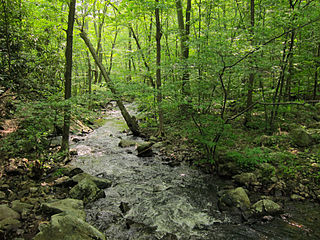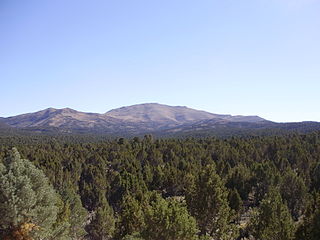
The Appalachian Mountains, often called the Appalachians, are a system of mountains in eastern to northeastern North America. The Appalachians first formed roughly 480 million years ago during the Ordovician Period. They once reached elevations similar to those of the Alps and the Rocky Mountains before experiencing natural erosion. The Appalachian chain is a barrier to east–west travel, as it forms a series of alternating ridgelines and valleys oriented in opposition to most highways and railroads running east–west.

The Northeastern coastal forests are a temperate broadleaf and mixed forests ecoregion of the northeast and middle Atlantic region of the United States. The ecoregion covers an area of 34,630 sq miles (89,691 km2) encompassing the Piedmont and coastal plain of seven states, extending from coastal southwestern Maine, southeastern New Hampshire, eastern Massachusetts, and Rhode Island, southward through Connecticut, New York State, New Jersey, southeast Pennsylvania, Delaware and Maryland.

The Atlantic coastal pine barrens is a now rare temperate coniferous forest ecoregion of the Northeast United States distinguished by unique species and topographical features, generally nutrient-poor, often acidic soils and a pine tree distribution once controlled by frequent fires.

The Sierra Madre Occidental pine–oak forests are a Temperate broadleaf and mixed forests ecoregion of the Sierra Madre Occidental range from the southwest USA region to the western part of Mexico. They are home to a large number of endemic plants and important habitat for wildlife.

The Appalachian mixed mesophytic forests is an ecoregion of the temperate broadleaf and mixed forests biome, as defined by the World Wildlife Fund. It consists of mesophytic plants west of the Appalachian Mountains in the Southeastern United States.

The Appalachian–Blue Ridge forests are an ecoregion in the Temperate broadleaf and mixed forests Biome, in the Eastern United States. The ecoregion is located in the central and southern Appalachian Mountains, including the Ridge-and-Valley Appalachians and the Blue Ridge Mountains. It covers an area of about 61,500 square miles (159,000 km2) in: northeast Alabama and Georgia, northwest South Carolina, eastern Tennessee, western North Carolina, Virginia, Maryland, and central West Virginia and Pennsylvania; and small extensions into Kentucky, New Jersey, and New York.

Pinyon–juniper woodland, also spelled piñon–juniper woodland, is a vegetation type (biome) of Western United States higher elevation deserts, characterized by being an open forest dominated by low, bushy, evergreen junipers, pinyon pines, and their associates which vary from region to region. The woodland's density and crown height varies dramatically depending on the site's soil and climate, the age of the stand, and the particular species present, with mature trees ranging in height from as low as 2 meters up to 15 meters. At lower elevations, junipers often predominate and trees are spaced widely, bordering on and mingling with grassland or shrubland. As elevation increases, pinyon pines become common and trees grow closer, forming denser canopies. Historically, pinyon-juniper woodland has provided a vital source of fuel and food for peoples of the American Southwest.

The California montane chaparral and woodlands is an ecoregion defined by the World Wildlife Fund, spanning 7,900 square miles (20,000 km2) of mountains in the Transverse Ranges, Peninsular Ranges, and Coast Ranges of southern and central California. The ecoregion is part of the larger California chaparral and woodlands ecoregion, and belongs to the Mediterranean forests, woodlands, and scrub biome.

The Allegheny Highlands forests are a temperate broadleaf and mixed forests ecoregion of North America, as defined by the World Wildlife Fund. The United States EPA defines the area as belonging to the Northern Central Appalachians and Northern Appalachain Plateau and Uplands ecoregions.

The Southeastern mixed forests are an ecoregion of the temperate broadleaf and mixed forest biome, in the lower portion of the Eastern United States.
The Central and southern Appalachian montane oak forest is a forest system found in the Appalachian Mountains of West Virginia, Virginia, Kentucky, Tennessee, North Carolina, South Carolina, and Georgia.
The Appalachian hemlock–northern hardwood forest is a forest system found in the Appalachian Mountains of New Hampshire, Vermont, Massachusetts, Connecticut, New York, New Jersey, Pennsylvania, Maryland, Virginia, West Virginia and western North Carolina. These forests occur in deep coves, moist flats, and ravines.
The Allegheny–Cumberland dry oak forest and woodland is a forest system found in Ohio, West Virginia, Virginia, Kentucky, Tennessee, Alabama, and Georgia.
The Southern Ridge and Valley / Cumberland dry calcareous forest is a forest system found in Alabama, Georgia, Tennessee, Kentucky, Virginia, and West Virginia.
The central Appalachian dry oak–pine forest is a forest system found from Maine south through New Hampshire, Vermont, Massachusetts, Rhode Island, Connecticut, New York, New Jersey, Pennsylvania, Maryland, to West Virginia and Virginia. It is abundant in the low- and mid-elevation central Appalachian Mountains and in the central Piedmont.
Central Appalachian pine–oak rocky woodland is a forest system found in Maine, Vermont, New Hampshire, Massachusetts, Connecticut, New York, New Jersey, Pennsylvania, Ohio, Kentucky, Virginia, Maryland, and West Virginia. It occurs on lower-elevation hilltops, outcrops, and rocky slopes in the central Appalachian Mountains, the Allegheny Plateau, and the northern Piedmont.

The Southeastern conifer forests are a temperate coniferous forest ecoregion of the southeastern United States. It is the largest conifer forest ecoregion east of the Mississippi River. It is also the southernmost instance of temperate coniferous forest within the Nearctic realm.

The upper montane forest is a vegetation type generally found above the mixed coniferous forest and below the subalpine forest vegetation types. Most of what grows in upper montane forests are conifers, because of the short growing season.

The Garden Mountain Cluster is a region in the Jefferson National Forest recognized by The Wilderness Society for its diversity of habitats extending along the east, south and west of Burke's Garden. The cluster, part of the Appalachian Mountains in southwest Virginia, connects wildlands in the high country of Garden Mountain and adjacent streams and ridges in one of the most remote areas of Virginia.

The Northwest Iberian montane forests is a Mediterranean forests, woodlands, and scrub ecoregion in southwestern Europe. It lies in the northwestern Iberian Peninsula, includes inland mountains, foothills, and plateaus in northwestern Spain and northeastern Portugal.














